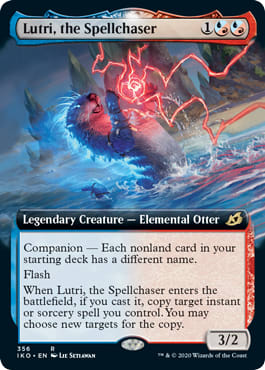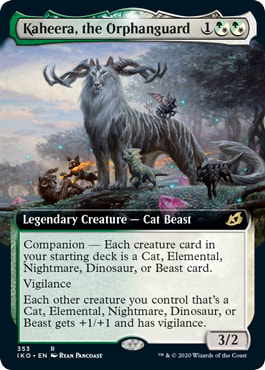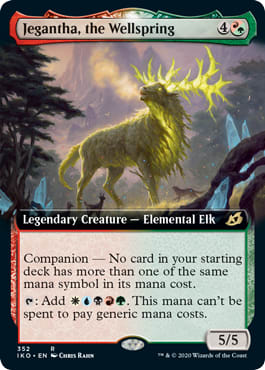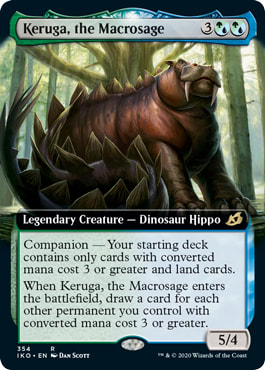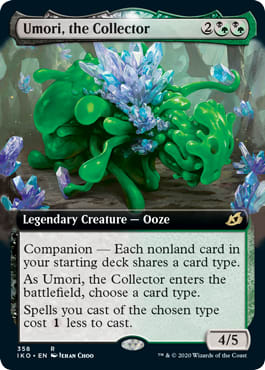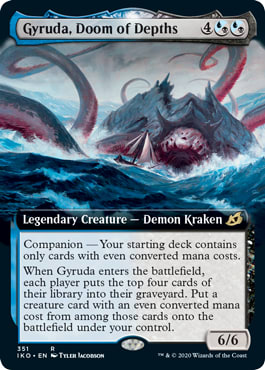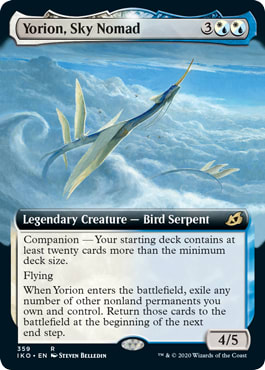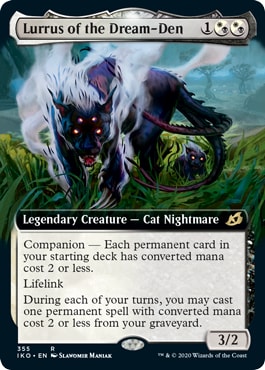Have I made it clear yet that companions have impacted Magic: The Gathering in a similar way that planeswalkers had when they were first revealed? I keep thinking about companions and I'm not sure where I land. On the one hand, maybe Wizards hasn't done anything about them because there aren't any major paper tournaments to witness, or to collect data from. On the other hand, maybe they haven't done anything because this was the goal all along. Just like planeswalkers perhaps companions were meant to force players to play on a different axis if they wanted to, and to not if they didn't.
It's certainly an interesting proposition, for sure, but no matter how you cut it, a specific few companions are definitely causing trouble, and in more than a few formats. Today I want to rank all ten of them, from the least problematic to the most, and I'd love for you to share your own thoughts with me in the comments below when we're all done. Let's get started!
10. Lutri, the Spellchaser
Man, Lutri ain't done nothing wrong. Fortunately, the only thing Lutri ever did wrong was get banned from Commander before he was even released. The reason being pretty obvious, since he's an auto-include in every Blue or Red deck based on his nonexistent Commander-esque requirements. Since his Commander banning, however, Lutri hasn't really seen much Constructed play in any format, so there's not really that much to say about him, which means he's probably at the perfect power level.
9. Kaheera, the Orphanguard
Kaheera is also not very exciting. There was a control deck that wasn't playing any creatures at all, that snuck a copy of Kaheera into their sideboard as a free eighth card. You might remember me talking about this, and how it felt like an issue for decks to be doing this, solely so they could start with an extra card in their hand. I'm still not sure this is a great precedent for Magic to set, but I also don't think Kaheera is really breaking any molds by being a generic 3/2 with vigilance in the decks it's been played in so far.
Other than that, there really haven't been many tribal decks centered around the legendary cat beast. As an aside, it's funny that Kaheera is only a cat beast, yet it pumps cats, beasts, elementals, nightmares, and dinosaurs. Why not make it a cat beast elemental nightmare dinosaur? Just some food for thought. Wizards, you have my number.
8, 7, and 6. Zirda, the Dawnwaker; Jegantha, the Wellspring; and Keruga, the Macrosage
I'm going to be honest: these are all pretty much tied. While they all do see some amount of competitive play, none of them are too dominant or really standing out that much. Again, these are all companions that have a power level that we should likely be fine with. Their abilities don't dominate entire formats, and their restrictions are all fairly reasonable. Not being able to play anything that costs less than 3 mana can be a big deal. Every permanent in your deck having an activated ability is also a pretty big deal. And all Jegantha does is add mana for you, which you should already have, considering you already cast it for five mana.
If I had to wager, I would say Zirda had the biggest potential to be broken, what with the Training Grounds impression it's doing and all that. But that still hasn't really happened yet. I would actually say that these are the sweet spots for companions. They allow you to be a little creative with your deck-building, and they reward you in a relatively fair way. My concern comes into play when people begin to look at their decks and say "what minimal changes can I make to start with an additional card," as I did with our deck last week, because I feel like that's outside of the spirit of companions.
5. Umori, the Collector
Umori is interesting, because I don't think the ability on the card is too powerful, especially considering the card itself costs four mana, so you won't be getting the discount until you already have four mana. But this restriction is also an interesting one, in that a lot of players are using it to play mono artifact decks, or even mono creature decks. When you're building the former, it allows you to have both artifacts, and artifact creatures, and Umori is going to give a discount on both.
For example, there's a ![]()
![]() Modern deck that uses Umori, along with 31 other creatures and 29 lands. So basically, they get a free creature on turn three with some ramp thanks to Umori, then they get to cast something like a Primeval Titan on turn four. The discount on the card itself isn't too bad, but when you realize it's a discount you're guaranteed to get every single game on a free card if you want it - and a 4/5 body for four-mana is quite sizable - then I think that's when it really makes us begin to wonder.
Modern deck that uses Umori, along with 31 other creatures and 29 lands. So basically, they get a free creature on turn three with some ramp thanks to Umori, then they get to cast something like a Primeval Titan on turn four. The discount on the card itself isn't too bad, but when you realize it's a discount you're guaranteed to get every single game on a free card if you want it - and a 4/5 body for four-mana is quite sizable - then I think that's when it really makes us begin to wonder.
Like, if there was a four-mana 4/5 that was legal in every format, that said "you may cast this from your library," and tapped to add a mana (let alone multiple mana, via cost reduction of an entire card type), we'd probably give it a second look. And that's basically what's happening here.
4. Obosh, the Preypiercer
Obosh is actually seeing even more play than Umori, and I think this is the point where we're really ramping up into the more competitive builds and companions. Having a one-sided Furnace of Rath effect on a 3/5 body is extremely efficient, especially since you can play this, and attack with all the creatures you'll already have on board. This card has already been seeing playing a ton of aggro and sacrifice decks in nearly all of the non-Eternal formats: Standard, Pioneer, and Modern.
Believe it or not, it's really not that difficult to pack your deck with cards that cost one or three mana (you're usually not playing many other 5-drops). And if I told you that you could have a one-sided Furnace of Rath in your opening hand every game, that couldn't be discarded, I think that would be a pretty strong selling point to start building a deck with it.
3. Gyruda, Doom of Depths
Gyruda doesn't have the same pedigree that the companions below him have, but I do believe he started this whole companion craze. If I'm not mistaken, the Standard Gyruda deck was the first one to really emphasize how powerful it was to start with an extra card in your hand that couldn't be discarded and never had to be drawn. In fact, truth be told, I was just thinking about it and I completely forgot what Gyruda's restriction was, because it just seems so irrelevant in the decks playing the card.
Gyruda was the card that got the whole ball rolling, as far as I can tell, or at least the one that put the problem under the microscope. The deck still seems to be pretty fun in Standard, but I don't think it's putting up the scary numbers that people were afraid of near the beginning.
2. Yorion, Sky Nomad
For the longest time, since the dawn of Magic in fact, people have championed the virtues of only playing 60 cards in your deck. You musn't play more than 60 cards! Heavens, don't play a 61st card! If you want to maximize your chances of drawing your best cards by 0.00000032%, you should only play 60 cards!
For as long as I've played Magic, I've kind of laughed at this. Yes, statistically, with only 60 cards, you give yourself the best chance at drawing your best cards. That's simple math. But the problem is that sometimes there just isn't a best card in your deck. While I believe this is especially true in Limited, in formats like Cube Draft particularly, where, while a card like Garruk Wildspeaker is the better card in your deck, you still may need a card like Acidic Slime.
I have frequently made the point that in every format, in every matchup, and even in every single situation, there is never a "best card" in your deck. It fluctuates as frequently as the turns pass. Sometimes you need a removal spell. Sometimes you need a way to deal with an artifact. Sometimes you need some life gain. Magic is a game that constantly changes, from minute to minute, so to deny your deck a way to deal with a specific problem simply because it decreases your odds of drawing a different card by fractions of a percent, is just silly to me.
Now imagine my surprise when, along comes Yorion, Sky Nomad, and all of a sudden no one has any problem playing not only 61 cards, but a ridiculous 80 cards! I think the best possible thing Yorion can do is force every 60-card-stickler to reevaluate why they will never play more than 60 cards. And you know the cost people were willing to pay to break their sacred 60-card beliefs, and add a full 20 extra cards to their decks?
Starting the game with one. Single. Extra. Card.
All this analysis of 60+ card decks aside, Yorion is the second most common companion, finding homes in Modern, Pioneer, and Standard, in a ton of decks. And I don't see that changing anytime soon. As long as Wizards want to make sure all the good creatures have "enters the battlefield" abilities, Yorion will be sought after to blink them. It also has, by far, one of the least restrictive, uh, restrictions. Cool, I'll put 20 more cards in my deck. It's arguably the opposite of a restriction if you're just playing a value deck with a bunch of value cards. Just add more! And people have.
1. Lurrus of the Dream-Den
Oh boy. This one is a mess. There's no other way to say it. Lurrus is the biggest mistake of all the companions. Maybe R&D forgot that 95% of the cards played in older formats had a cost of two or less, so this would basically be free in most decks? I don't know. This one is hard to explain, but if I had to wager any companion was going to see a ban, it would be this one by a country mile.
But not only is it seeing play in formats like Vintage and Legacy, it's extremely popular in the Modern Burn decks. There are ![]()
![]() and
and ![]()
![]() Standard decks with Lurrus. There are Aura decks in Pioneer with the card, because remember, there was a Pioneer version of Bogles that never played anything that cost more than two. Why not just add a free Lurrus!
Standard decks with Lurrus. There are Aura decks in Pioneer with the card, because remember, there was a Pioneer version of Bogles that never played anything that cost more than two. Why not just add a free Lurrus!
My biggest problem with companions is when existing decks just get to add them for free. It requires no innovative deck-building. It isn't a restriction. It's just a card that changes the rules of the game, that made an existing deck better with nominal cost. And I think that's about where Lurrus is sitting right now; Yorion too, in fact.
But what do you all think? Are the companions a net positive for the game? Were they a mistake? How are you guys feeling after having two weeks with them in all of our competitive formats? I'm really curious to hear your thoughts. Are they just new planeswalkers, or rather, cards we have to get used to? Sound off below and let me know!
As always, thank you guys so much for reading, I love you all, and I hope you're staying safe. Use promo code FRANK5 to save some cheddar, and I'll catch you guys next week!
Frank Lepore
















